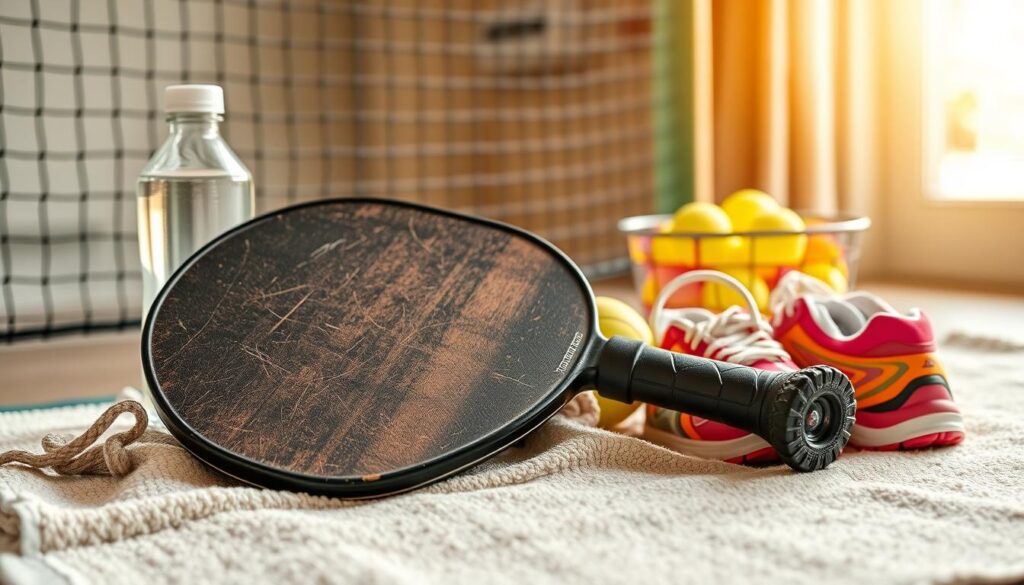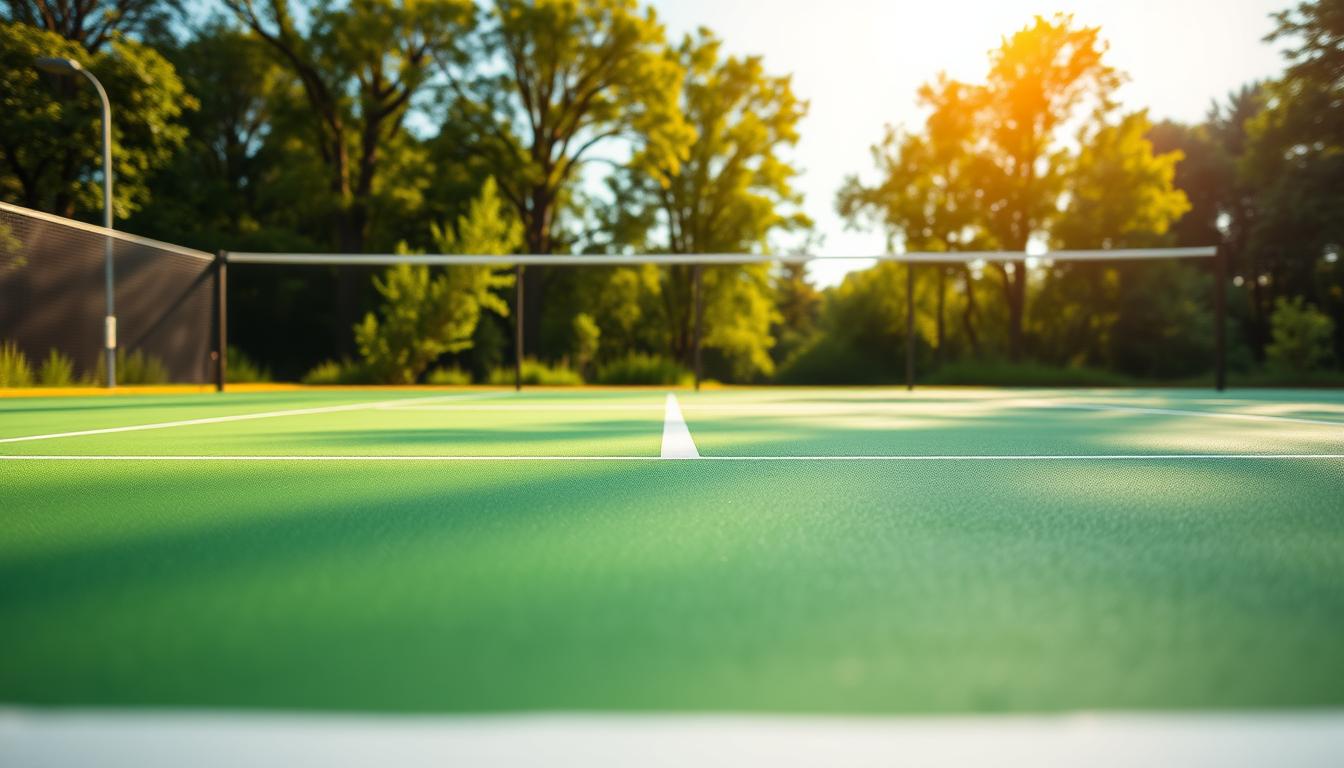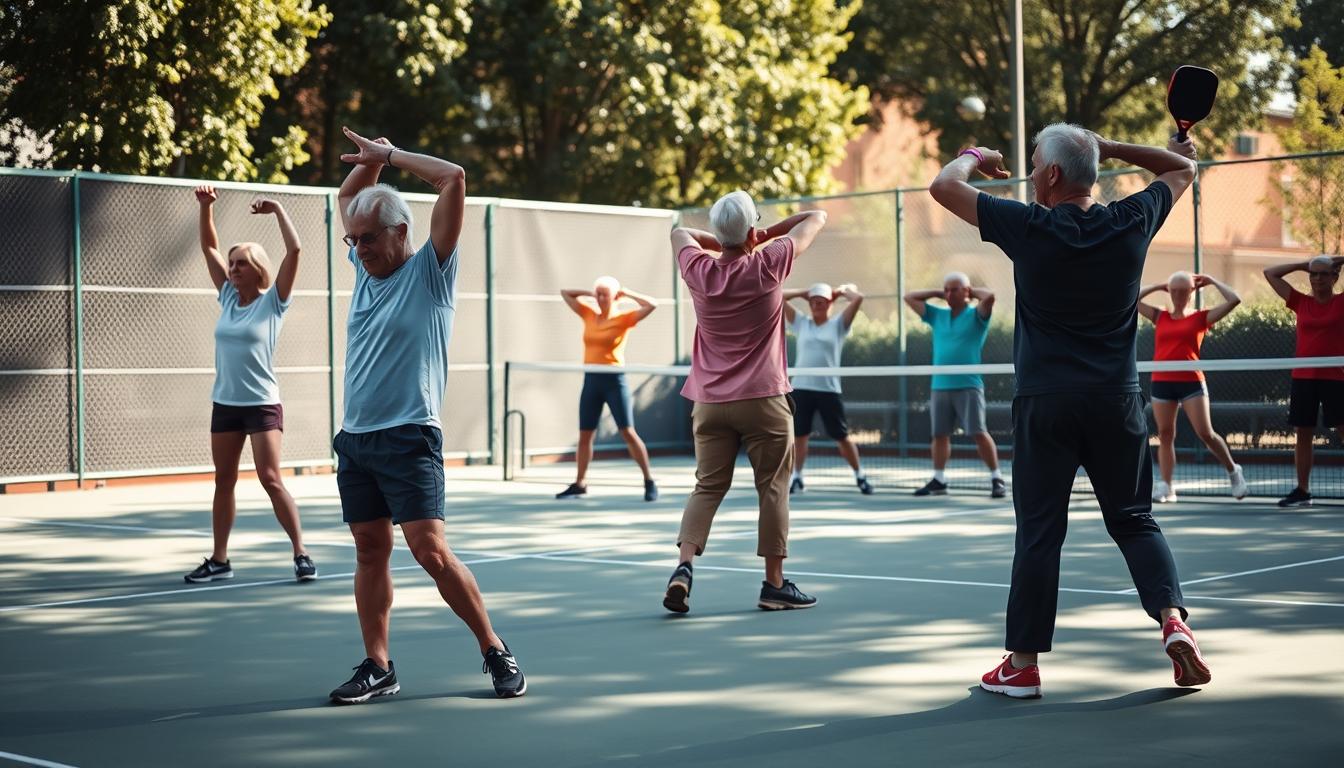Can a few simple routines really keep your equipment playing like new? This guide shows how small actions extend the life of your paddle, balls, shoes, and bag while supporting plant-based cleaning choices.
Start with quick wipes after each match using a microfiber cloth and a mild, plant-based soap or a vinegar-water mix. Avoid harsh cleaners, never soak paddle edges, and keep items dry to stop glue failure and delamination.
Store balls in a cool, dry place away from hot cars or damp garages to protect bounce. Rotate shoes, check tread, and replace sweaty grips when needed to preserve performance and reduce injury risk.
Off-season, clean and fully dry everything, loosen laces, wrap paddles, and elevate bags. Add silica gel packets to control moisture and prevent warping. These low-effort tips help players save time and money while keeping the game reliable.
Why Gear Care Matters for Senior Pickleball Players
A simple habit of routine checks and light cleaning makes a big difference in shot accuracy and injury prevention.

Clean, well-kept equipment directly supports consistent performance on the court. Dirty surfaces reduce paddle grip and lower spin control. Worn shoes change your stance and raise the chance of trips or ankle strains.
Performance, comfort, and safety on the court
Routine inspections catch issues early. Look for soft spots on a paddle, dull strike sounds, compressed shoe midsoles, or cracked balls. Fixing small faults avoids mishits and sudden replacements during a match.
“A neglected paddle or flattened shoe can cost you a point and increase injury risk.”
- Wipe paddles dry and store them in a temperate spot to protect adhesives and cores.
- Air shoes after play and rotate pairs to extend cushioning life.
- Keep balls in a cool place to preserve bounce and consistent tempo.
| Issue | Sign | Action |
|---|---|---|
| Paddle surface | Loss of grip / soft spot | Wipe, dry, inspect edge guard |
| Shoes | Flat cushioning / worn tread | Air out, replace when cushioning is compressed |
| Balls | Cracks / inconsistent bounce | Store cool; replace if dented |
Vegan-Friendly Cleaning Toolkit for Pickleball Equipment
Build a compact kit that makes post-play upkeep simple and reliable.
Keep a microfiber cloth, mild plant-based soap, and a small spray bottle of a 1:1 vinegar-water mix in your bag. Use the damp cloth to lift dirt from a paddle surface and the same routine for a single ball spot-clean. Wipe dry right away to protect edges and adhesives.

Microfiber cloths, plant-based soap, and vinegar-water solutions
Microfiber cloths work well because they trap grit without scratching. A light soap solution plus water removes sweat and oils without leaving residue. Vinegar-water and biodegradable wipes are handy eco-friendly choices for quick on-the-go use.
What to avoid: harsh chemicals, bleach, ammonia, and abrasives
Avoid bleach, ammonia, and rough scouring pads. These chemicals strip finishes and weaken cores over time. Choose cruelty-free materials and biodegradable wipes to protect surfaces and extend equipment life.
- Pack a labeled kit with cloth, soap, spray bottle, and silica packets for bags.
- Keep a soft brush for stubborn dirt, then finish with a damp cloth so surfaces stay tacky, not slick.
- Add soap and cloths to your online cart with replacement grips for seasonal refreshes.
“Simple tools used consistently will keep your equipment game-ready and extend its useful life.”
Step-by-Step Paddle Care Using Vegan Products
Keep cleaning simple and focused so your paddle stays consistent match after match.
Clean the paddle surface with a damp microfiber cloth and mild soap
Start by brushing loose grit from the paddle surface with a dry microfiber cloth. Then use a cloth lightly dampened with plant-based soap and water to lift oils and dirt.
Wipe immediately with a dry cloth so you don’t leave residue that changes texture.
Raw carbon fiber paddles: use a carbon fiber cleaning block
For raw carbon fiber, use a carbon fiber cleaning block in gentle circular motions. This removes embedded ball residue without liquid residues that can dull the face.
Grip and overgrip maintenance
Wipe sweat from the handle after play. Replace grips or add overgrips made from cruelty-free materials to keep tack and comfort.
Water exposure and edge protection
Never soak the paddle; the honeycomb core can trap water and warp. Dry seams and the handle thoroughly.
Check the edge guard for scuffs and use edge guard tape on edgeless frames. Store each paddle in a fitted paddle cover to avoid scratches and UV wear.
“A quick wipe and a dry paddle prevent small problems from becoming season-ending ones.”
Pickleballs: Cleaning, Storage, and Bounce Preservation
A quick wipe and proper storage keep balls bouncing true and match-ready.
Wipe dirt off after play with a damp cloth. Use just enough water to lift grime. Avoid soaking holes or seams so the ball does not trap water.
Wipe dirt with a damp cloth to maintain consistent bounce
Light cleaning removes dust that dulls rebound. If a ball looks dusty, a gentle rinse followed by towel-dry works. Do not use strong detergents that leave slick residue.
Store balls in a cool, dry place—avoid heat and extreme temperatures
Keep balls in a shaded, moderate place. Direct sun, heater vents, or a hot trunk can flatten a ball quickly. Extreme temperatures deform plastic and harm performance.
- Keep balls game-ready by wiping away dirt with a damp cloth; use minimal water.
- Rotate sets so wear is even; separate indoor and outdoor pickleballs for consistent feel.
- Do quick bounce checks against the paddle or court; replace any ball that rebounds flat.
“Consistent cleaning and storage protect your equipment investment and help shots land the way you expect.”
Shoes and Bags: Odor Control, Longevity, and Organization
Airflow, light cleaning, and smart storage go a long way toward keeping shoes and bags match-ready.
After each session, remove insoles and air shoes in a ventilated spot. Let humidity and sweat dissipate so cushioning and adhesives last longer.
Wipe interiors with a lightly damp cloth and let shoes dry fully to stop mildew from degrading materials.
Shoe inspection and rotation
Check tread for balding spots and look for midsole compression lines. Replace shoes when traction drops or shock absorption feels flat during play.
Rotate two pairs if you play multiple times per week so foam rebounds fully between outings and extends usable life.
Deodorize safely
Use non-toxic deodorizing sprays or a sprinkle of baking soda to control smell without heavy fragrances. Keep products that won’t irritate skin or leave residues.
Organized, ventilated bags
Choose a ventilated bag with compartments to keep shoes away from clean clothes and to store paddles, balls, and grips separately.
- Keep a small maintenance pouch with baking soda, spare laces, and overgrips.
- Avoid machine washing shoes or using high heat; spot clean to protect structure.
- Log purchase dates and estimated miles to plan timely replacements and avoid surprise slips.
“A short routine after play saves time later and keeps equipment reliable on court.”
Climate-Smart Storage for U.S. Conditions
Protecting paddles, balls, and bags from extreme temperatures extends life and saves money.
Protect paddles from rapid swings in temperature. Cold makes composites brittle. Heat softens faces and can cause delamination.
Never leave equipment in a hot car or a freezing garage. Short spikes of heat or cold damage adhesives and warp frames.
Store items at room temperature, elevated off damp floors. A closet shelf or a high rack keeps items away from concrete that wicks moisture.
Place silica gel packets in compartments to absorb humidity after rainy play. Replace packets seasonally or after heavy exposure.
- For club use, avoid leaving your bag in a metal cart near heaters—move it indoors when possible.
- When transporting in hot weather, shade the interior and crack windows; bring paddles inside during breaks.
- In winter, let cold equipment warm indoors before play to prevent stress on materials.
| Risk | Effect | Best Place | Quick Fix |
|---|---|---|---|
| High heat | Face softening, glue failure | Cool closet shelf | Move indoors; use shade |
| Freezing cold | Core brittleness, cracking | Room-temperature cabinet | Acclimate indoors before play |
| High humidity | Mold, padding breakdown | Elevated, ventilated place | Use silica packets; air out |
“A small storage habit keeps paddles playable and prevents costly delamination.”
Seasonal and Long-Term Maintenance Routines
A brief end-of-season routine preserves performance and saves time when play resumes.
After your final session before a break, clean and dry everything right away. Loosen shoe laces to relieve eyelet stress and let footwear air fully. Wrap paddles in a soft cloth or store them in a paddle cover at room temperature to avoid warping.
Add silica gel packets to bags and cases to stabilize humidity. Elevate bags and paddles off concrete to encourage airflow and prevent moisture transfer. These small steps protect adhesives, foams, and finishes during long storage.
- Set a seasonal maintenance calendar to clean, dry, and organize equipment after your last session.
- Inspect for wear: chips, cracks, dull paddle sound, and soft spots. Note borderline issues for early repairs.
- Refresh grips or overgrips before the new season to restore tack and reduce wrist strain.
- Separate older balls for drills and mark fresh ones for matches to keep bounce consistent.
- Log dates and photos so you can track condition over years and plan replacements.
| Task | Why it matters | Quick action |
|---|---|---|
| Clean & dry | Prevents mold and adhesive breakdown | Wipe, air, and dry before storage |
| Loosen laces & elevate | Relieves pressure on eyelets; improves airflow | Untie one notch; place on shelf |
| Silica gel & covers | Controls humidity and prevents warping | Add 2–3 packets per bag; use paddle cover |
| Inspect & log | Detects wear early and extends usable years | Tap test, bounce check, photo log |
“A short seasonal checklist avoids surprises and keeps equipment match-ready.”
Vegan Pickleball Seniors Gear Care: Replacement Signs and Lifespan
Expect a paddle lifespan of roughly one to five years depending on play frequency, impacts, and storage. Routine checks spot fading performance before a full failure.
Paddles: when surface grip fades, edge guard cracks, or “pop” is gone
Replace a paddle when the strike sounds muted or the surface no longer grips the ball. Tap the face to compare tones; inconsistent notes signal internal separation.
Inspect the edge guard and frame for chips or cracks. Damage here often precedes broader structural failure and shortens useful years.
Balls and shoes: dented balls, flat bounce; worn tread and compressed midsoles
Swap out balls when dents persist after squeezing or bounce tests show a much lower rebound than fresh stock. Flat balls change timing and shot feel.
Check shoes for worn tread and compressed midsoles. If traction slips or joints ache after play, replace footwear to protect movement and reduce injury risk.
- Expect a paddle lifespan of one to five years based on use and storage habits.
- Replace paddles when the pop is gone, spin drops, or soft spots appear on the face.
- Swap balls that stay dented or rebound flat; rotate sets to extend usable life.
- Update shoes when tread thins or cushioning no longer cushions impact.
- Keep notes on purchase dates and session counts to judge condition and timing.
“Timely replacement protects performance and reduces strain on the body.”
Good upkeep extends life, but clear signs of decline mean it’s safer to replace than to push an item past its useful condition.
Conclusion
Keeping a short maintenance habit prevents surprises during matches and travel.
Routine cleaning with a microfiber cloth and mild soap or a vinegar-water option, plus prompt drying, will extend the life and lifespan of your paddle and other equipment.
Store paddles in a paddle cover, use ventilated bags, and keep items in a cool place. Off-season, wrap paddles, loosen laces, elevate storage, and add silica gel to control humidity.
The best way to protect performance is to use gentle cleaners, dry promptly, and organize a spot for everything in your bag. Save this blog as a quick reference before tournaments, and share it with teammates so everyone arrives ready for play on the court.




